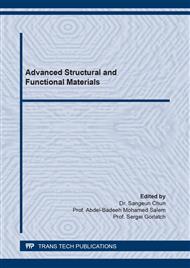p.123
p.135
p.141
p.151
p.161
p.169
p.179
p.187
p.193
Effect of Calcium Hydroxide Content on Pozzolanic Reaction of Calcined Clays: Their Mechanical Properties and Microstructures
Abstract:
The research aimed to investigate the effect of calcium hydroxide content on pozzolanic reaction of calcined clays. Pozzolanic reaction of calcined clay was determined in terms of its mechanical properties, phase development and microstructures. Three clay minerals (two kaolinitic clays and kaolinite-montmorillonite clay) were chosen to produce pozzolanic materials via calcination at temperature of 700 °C to allow dehydroxylation of clay minerals. Ratios of calcium hydroxide to calcined clays were varied from 0.1 to 0.5. Mixing water contents or liquid to solid ratios (0.62, 0.75 and 0.80) and curing times (7 and 28 days) were also studied. It was found that calcium aluminosilicate hydrate (stratlingite) could be formed after pozzolanic reactions of all clay minerals. The development of stratlingite agreed with the strength development showing the highest compressive strength at 26 MPa (28 days) when kaolinite-montmorillonite clay was used as pozzolanic material and the ratio of calcium hydroxide to calcined clay was 0.5.
Info:
Periodical:
Pages:
161-168
Citation:
Online since:
June 2021
Authors:
Keywords:
Price:
Сopyright:
© 2021 Trans Tech Publications Ltd. All Rights Reserved
Share:
Citation:


